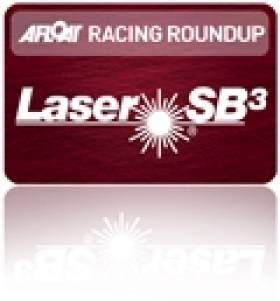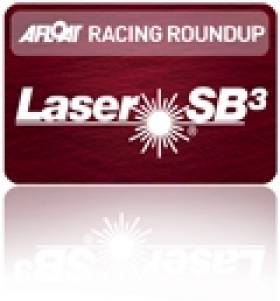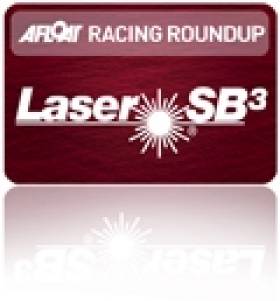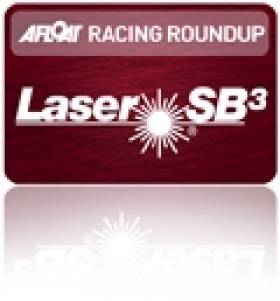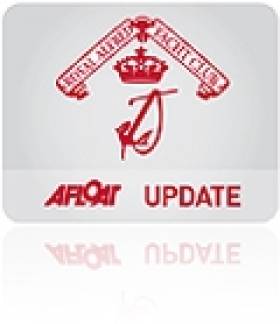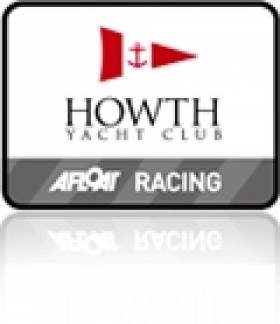Displaying items by tag: SB3
Galway Bay Event Sets Scene for Nationals decider
With breeze on at nearly every round this year the battle for honours at the front of the SB3 fleet has been compared to a tennis match between McCready Gill Racing and Sharkbait.
The opening salvo of the year took place at the Easterns, hosted by the Royal St George in May,
Galway Bay Sailing Club hosted the latest instalment of this epic battle, the SB3 Ireland Western Championships, over the weekend. The legacy of the city being host to the 2008 Volvo stopover means that, with the addition of a few further basic amenities, Galway is now a first class championship venue. The fleet were hosted by Galway Harbour Company in the docks and clear water out to the west meant the course had superb wave conditions to go with the 20-25kts of breeze. Ideal conditions for ripping it up in an SB3. But for a single 30kt squal the breeze barely wavered all weekend putting boatspeed, technique and fleet management skills to the fore.
Dave Quinn and the crew of Investwise have been in increasly fine form at HYC so it was no surprise to see them storm off the line to round the first windward mark in the lead. Sharkbait looked to follow them but badly misread the tide and had to eject out below the windward mark eventually rounding 6th with McCready Gill Racing in 4th. The first helterskelter run of the weekend followed with the entire fleet powering down the run under A-sails at the bottom of which Sharkbait pulled through the last couple of boats to take the lead on the drop. From there they eased away to a comanding lead whilst back in 3rd McCreadys spun out at the final gate (caught on camera for the entertainment of the masses in the bar that evening) and went wide of the gate. Once they realised their error they retired from the race leaving Investwise a comfortable 2nd with Lia in third followed by Belfast Kitchens and Duff Beer in 4th and 5th.
In the second race the trio including Loch Derg stalwarts Geoff O'Donoghue and Michael McCarney launched out of the left and into an early lead closely followed by Ronan Downing in Profile Park. But the pack slowly hunted them down with Sharkbait taking their second win, followed by the McCreadys. Profle Park held on for 3rd followed by Belfast Kitchens and Lia.
In the third and final race of the first day Sharkbait jumped clear off the first line with a significant bias to take up a controlling position. Marking the fleet most of the race they let slip at the top half to let Peter Kennedy through. PK, Tom Molloy and Peter Mackel on Belfast Kitchens sailed up the beat to round first with inches to spare. Down the run the McCreadys belted out to the left hand side of the run while the two leaders headed off neck and neck down the right. Belfast Kitchens held their own with Sharkbait down the run leaving a frantic pressure drop from both boats at the leeward gate. Bow vs bow to get the kites down and under control it was honours even as Sharkbait closed to within inches of Belfast Kitchen's stern before being ready to tack off. Both boats crossed tacks half way up the final beat with Belfast Kitchens having extended to a 2 boatlength lead. Both teams worked their boats for all they were worth and the finish was greated with celebration on the Northern Irish boat as they took the pin end line bias for a win by feet to serve notice that they will be there to defend their National title come September. Discount them at your peril. McCready Gill Racing came 3rd with Sean Craig, Stephen Boyle and Alan Green in Yeti making their first appearance at the front of the fleet this year from Profile Park.
With the lock gates firmly closed until 1pm on Sunday full advantage was taken of the Captains Morgans sponsorship at McSwiggans Bar in the evening. As the poster said 'we're off the edge of the map now lads, here be monsters!'.
On Sunday afternoon a steady 18-20kts westerly welcomed the competitors back to the race course. Despite enjoying all that Galway has to offer for the evening Dave Barry wiggled Lia up the first beat to round first, followed by Sharkbait and McCready Gill Racing. All the Lake Garda practice paid off when their kite went up with a wrap. they gybed off smartly undoing the wrap and holding 3rd to the end of the race. Sharkbait powered away to an early lead down the run with the McCreadys' hot on their heels and an early drop closed the race right back up again. Patrolling the middle of the course up the second beat Sharkbait took a 10 boatlength lead into the final run which they extended to 15 boat lengths before wiping out in the final gybe of the race. All the advice on broach recovery came in handy and but by the time the kite was back up the mast McCready Gill Racing where hot on their heels. Perfect drops from both boats at the gate and a game of tack and cover to the line saw the Howth team home for their 3rd bullet sewing up the event. Game Sharkbait.
In the 5th and final race McCready Gill Racing tidied up 2nd place overall with a race win from Dinghy Supplies, Monkey, Duff Beer and Yeti.
Photograph below by Olivier Bauduin
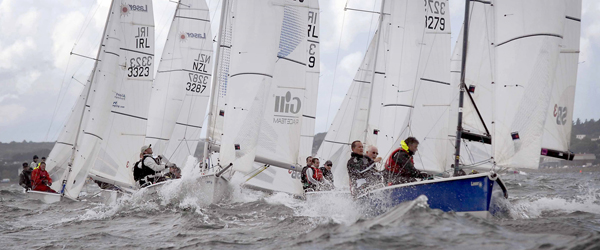
After six races sailed on shift Lakec Garda two Belfast boats are vying for the top Irish slot at the the the Volvo Laser SB3 World Championship. David Cheyne,Bob Espey and Richie McCullough of Royal Northern Ireland Yacht Club are 26th and Gareth Flannigan, Gareth Flannigan, Michael Ferguson and Brian Spence are 30th. Results available to download below. Photos below.
With freshly split fleets, the fleet took to the water at lunchtime for races 4, 5 and 6 of the Championship. The wind arrived from the south, as per schedule.
The fleet racing on Course Alpha split course sides on the first beat of the day. Those who picked the right hand side benefitted, Nick Phillip's "Chaotic" (GBR) rounded the windward mark first and set off to dice with the windsurfers at the leeward gate. Carsten Kemmling (GER) sailing Else showed great pace today. As the fleet roared downwind for the 2nd time creating a wall of spray as the wind built, their faces said it all. With grins from ear to ear, these were perfect conditions for Laser SB3 sailing! Nick Philips capitalised on his great early lead to win the first race.
Course Bravo enjoyed stronger wind from the start of the day, and by the beginning of the second race, the wind had built to a consistent 18 knots. As soon as the fleet crossed the line, the race was on to hit the cliffs and start short tacking up the shoreline. As the fleet rounded the windward mark for the first time, there was much less separation of the fleet, than seen on Course Alpha.
Ian Ainslie (RSA) onboard Team Proximo sailed a perfect second race today. Ainslie started at the Committee Boat end of the line and quickly picked his way to the front of the fleet, where he stayed for the rest of the race. By the end of the second downwind leg of the race, Ainslie had extended his lead to a full leg; as he rounded the final leeward mark of the course and dropped his kite, the final boat was rounding the spreader mark at the top of the course. Impressive sailing after a difficult day yesterday, Team Proximo are back in contention for the Championships.
Course Alpha struggled with their starts today, due to the consistently shifting wind. Roberta Righetti finally raised a black flag on the final race of the day, following the fifth general recall in 2 races. "It was extremely difficult for the fleet with the shifting wind, with 1 minute and then 30 seconds to go before the start they were well behind the line and with just moments to go they were all taken over with a wind shift. That is why I continued to start the race with flag papa.
By the time the final race on Course Alpha was started the fleet from Course Bravo were already ashore enjoying some of the fantastic Torbole hospitality. Italian LaserPerformance dealer, Peitro Negri (ITA) and his crew onboard Stenghele won the final race of the day, the first win of the Championship for the host nation!
With the qualifying races of the Volvo Laser SB3 World Championships completed, the finals races begin tomorrow. Going into the finals, Craig Burlton (GBR) still leads the fleet, by 1 point. Jerry Hill (GBR) and Luka Rodion (RUS) both finish 6 races with 14 points, following 1 discard. They are split on count back with Hill in the lead. The pressure is on at the top of the gold fleet. It will take mental strength as well as sailing skill to win this event.
Championship website: www.worlds2010.lasersb3.com
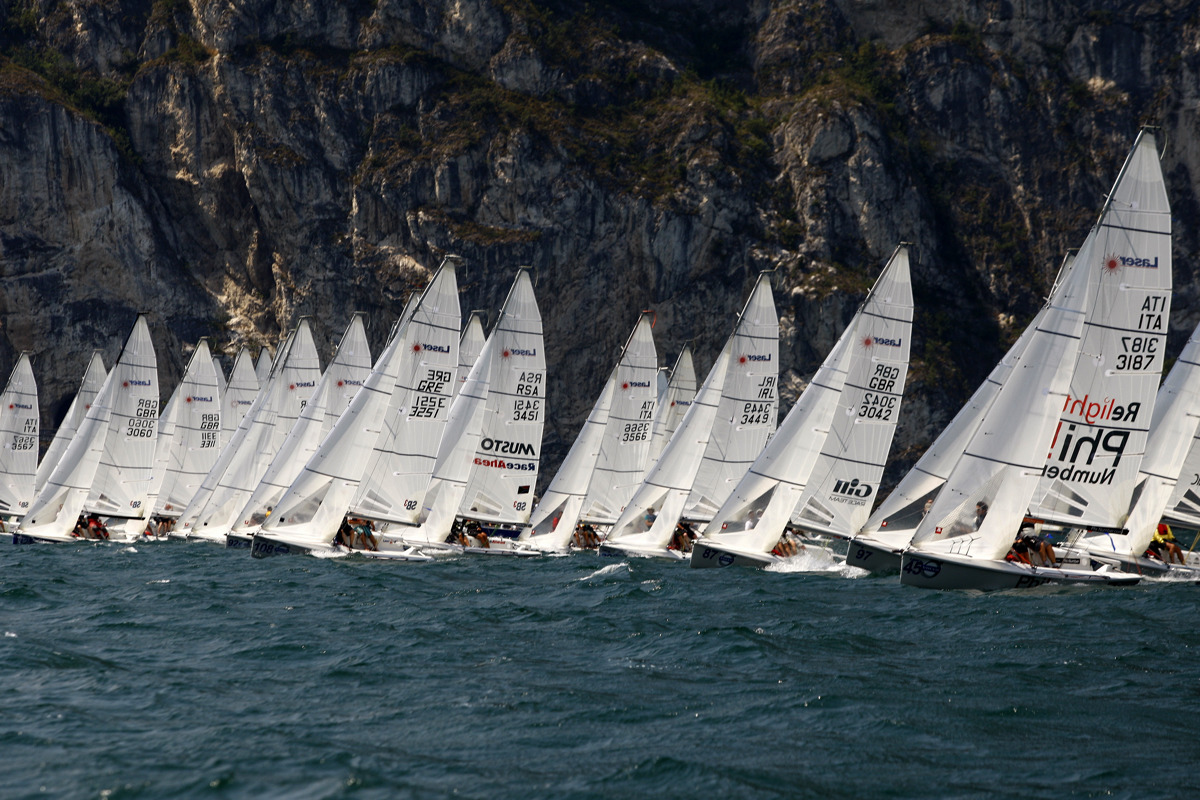
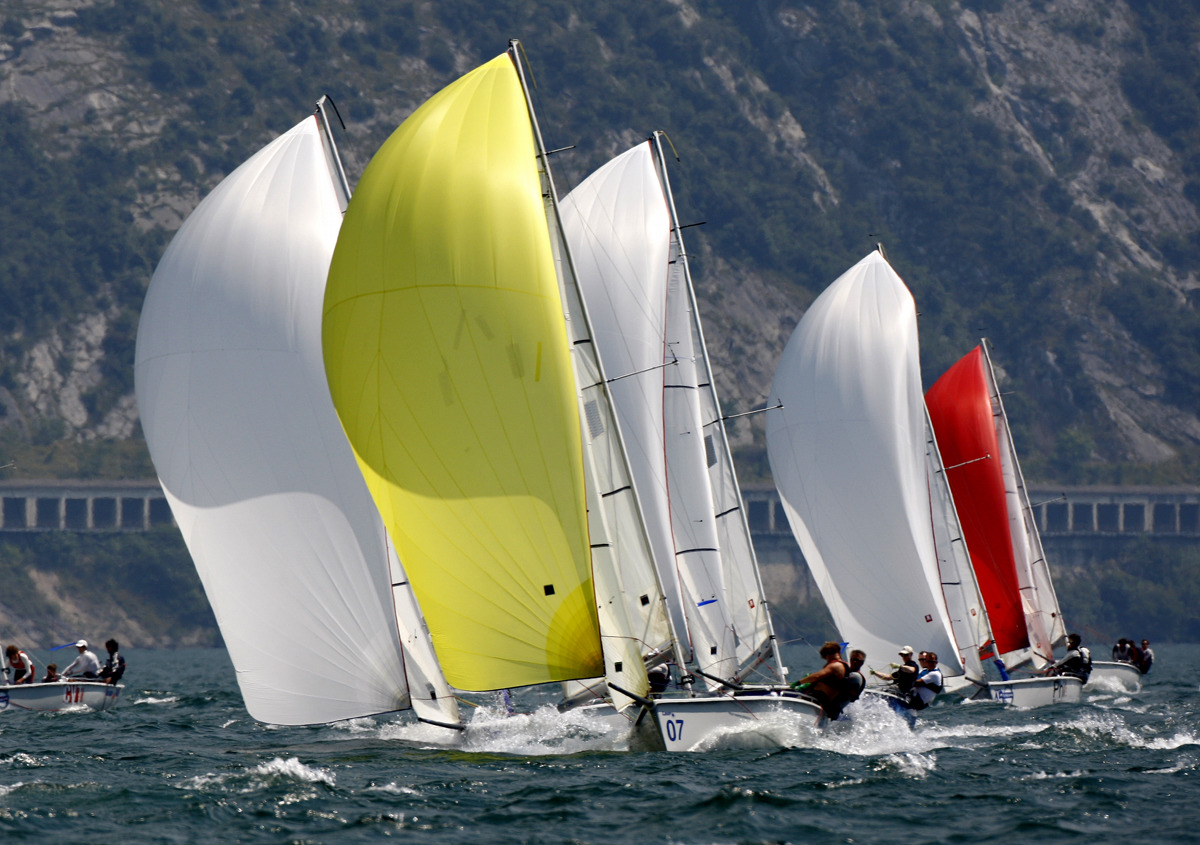
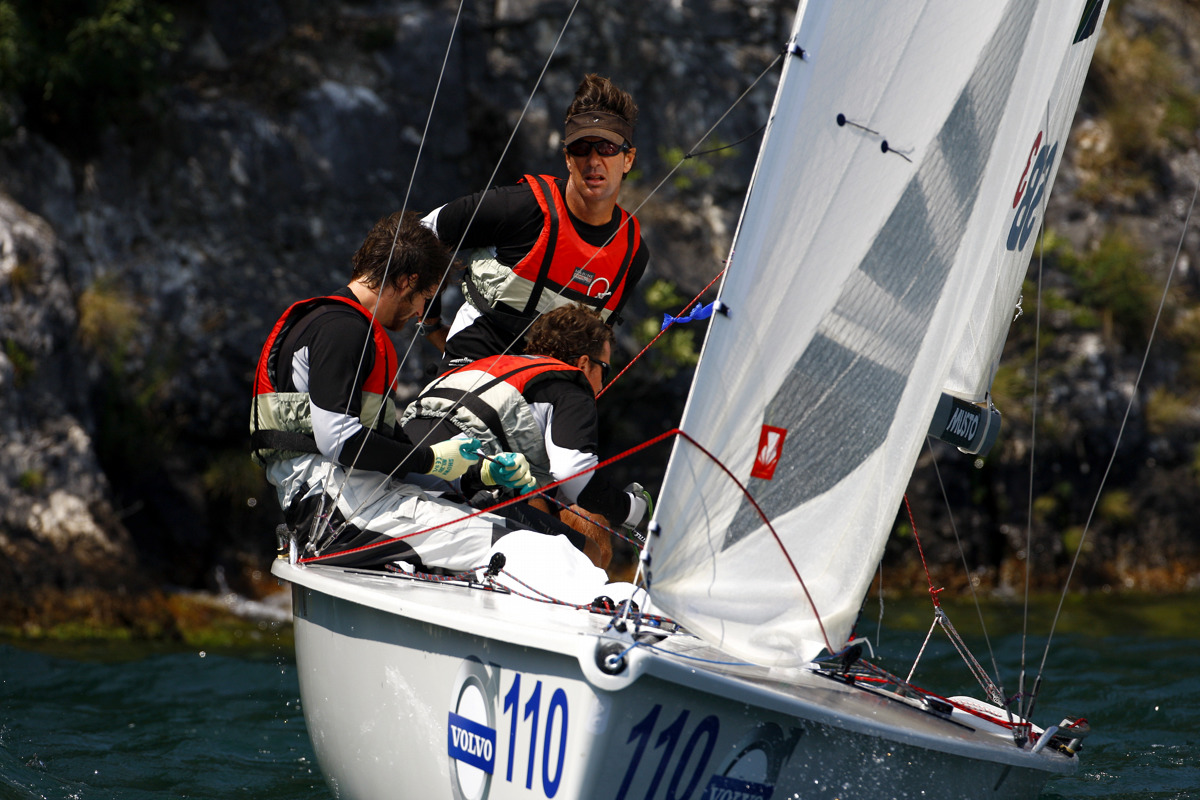
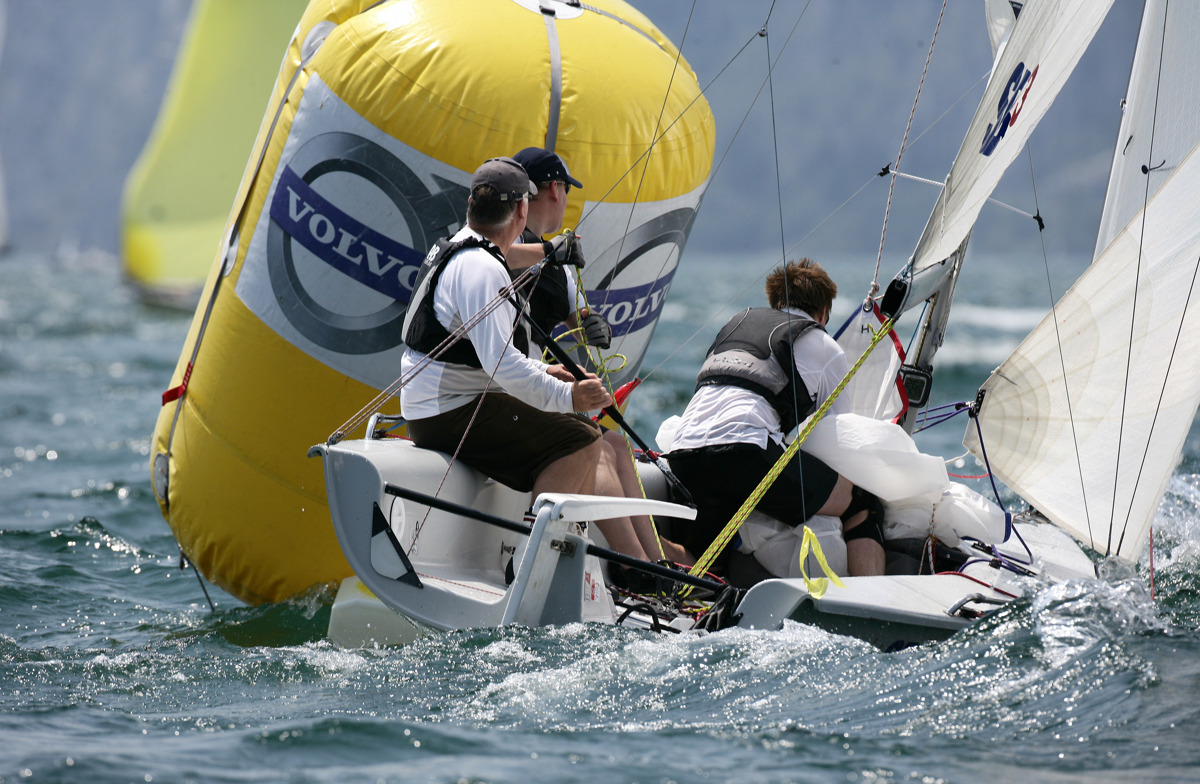
Ballyholme's Flannigan is Top Irish SB3 on Lake Garda
Gareth Flannigan, Michael Ferguson and Brian Spenc, Ballyholme Yacht Club lead are top Irish boat at the Volvo Laser SB3 World Championships 2010 at Torbole on Lake Garda, Italy. Three races were scheduled on two race courses, Course Alfa "Torbole" (yell0w) and Course Bravo "Riva" (blue). The Ballyholme trio lie 23rd. Full results available for download below.
Watching the racing from the Committee Boat on Course Alpha, it was clear that the racing conditions were exactly as described in the brochure, "At 1230 hrs, the Ora wind will arrive from the south of the Lake"....and it did, enabling Principal Race Officer Roberta Righetti, to get the fleet away on time with a clear start. Course Brava started soon after, having suffered a slight delayed whilst the Race Committee struggled to anchor the pin end mark.
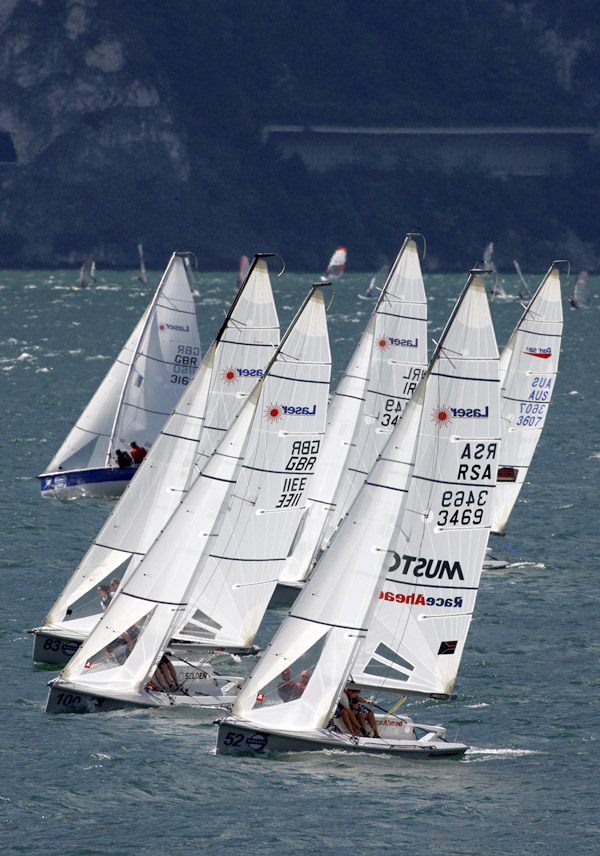
Tightly bunched: Dave Barry, Dan O'Conell and Breffni Jones of Howth Yacht Club (IRL 3449) competing in today's first race. Photo Carloni Grasso
Typically for Course Alpha, the fleet bunched at the pin end of the start line, before heading off to hug the shore all the way to the windward mark. The same side of the course remained the favourite for downwind leg. Luca Bacci (ITA) rounded the windward mark in first place, and lead for the remainder of the race, extending his lead at times to over 150 metres as the wind built. Bacci (ITA) went on to win race 1 on Course A, followed by Sarah Allan (GBR), Craig Burlton (GBR) and Mark Rushall (GBR). All 3 boats all sponsored by Gill.
Course Bravo enjoyed, "Perfect Riva racing conditions" according to Jerry Hill (GBR) helm of 3 Sad Old Blokes. "With a 3, 5, 1 today the Sad Old Blokes have plenty to build on and Grunter (bowman Grant Rollerson) showed his grunt at the front of the ship."
Team Proximo (RSA) helmed by Ian Ainslie suffered a broken pole during the first downwind leg of race 1 forcing them to sail without a pole for the rest of the race in which they still managed to finish second. Their subsequent results will be a disappointment to their event ambitions.
Current Laser SB3 World Champions Craig Burlton leads the fleet overnight. When ask how his day was he answered, "Hard, very hard. But great fun."
Racing continues tomorrow when the fleets will split again onto the two courses, this time sorted by odd and even finishing position. For now, the crews return ashore happy after a great days competition to enjoy a feast of pasta and beer provided by Circolo Vela Torbole.
SB3 World Championships Tops 100 Entries
Representatives from sixteen nations will compete in the World Championships, the largest spread of that the Laser SB3 class has ever enjoyed. Forty boats will attend from the UK, still the largest national entry and the host nation field a twenty boat entry, their largest turn out to a World Championships yet. Entries come from as far afield as Australia, Singapore, United Arab Emirates and South Africa. Ireland, France, The Netherlands, Portugal, Switzerland, Belgium, Austria, Germany, Ukraine and Russia will all be represented in Torbole in July.
The two Laser SB3 World Champions, Geoff Carveth (2008 Champion, Dun Laoghaire) and Craig Burlton (2009 Champion, Cascais) will both compete again for the Championship title and the honour of lifting the Waterford Crystal Trophy on Friday 23 July. Both Carveth and Burlton are British and so far the Laser SB3 World Championship has not been won by another nation. John Pollard, another British sailor recently won the Laser SB3 Volvo Cup on Lake Garda by a good margin and will be gunning hard for the top of the fleet.
However, this event is far from a walk over for the Brits! Tough competition will be provided by the Russian entry helmed by Ukrainian Rodion Luka who recently won the Laser SB3 Eurocup in Morgat, France. Luka, who took silver at the 2004 Olympics in Athens in the 49er class has already demonstrated good boat speed and hot tactics on the race course. Father and son, David and Roger Hudson, the founders of the South African sailing foundation “Race Ahead”, will field two entries, crewed by sailors from the foundation. Race Ahead has achieved second at the World Championships in 2008 and 2009. Will it be third time lucky for them?
For a number of the crews taking part in the 2010 Laser SB3 World Championships, this will be their first trip to Lake Garda, but for many, a trip down memory lane. Laser SB3 World Class President Dave Cheyne (IRL) can barely contain his excitement! “We have some mouth watering racing ahead of us! There are forty seven entries already for the Italian Nationals, we have an absolutely incredible few weeks of sailing coming up!”
Entrants will be split into two qualifying fleets for the first six races of the World Championships. Gold and silver fleet finals will begin on Wednesday 21st July. For anybody still wanting to enter, there is still time. Please contact Katie Ashworth via the website for further details.
The Laser SB3 Italian National Championships will take place in Torbole, from 25th – 27th June. A number of keen teams from across Europe will travel to Italy early for a pre-match warm up and to eye up the local competition.
LaserPerformance through Italian dealer Negri Nautica www.negrinautica.com will provide event support to the Italian Nationals and the World Championships ensuring every boat is able to race each day. Negri Nautica will also be making special offers to the fleet on spares and sails.
The Laser SB3 Class proudly claims to be one of the most tightly restricted one design keelboat classes in the world with little variation from the builder’s final product permitted. With minimal maintenance, easy to trail and low campaign cost, the class thrives on its philosophy of providing inclusive, high intensity, great fun and easily attainable, quality racing for it’s members.
There was a familiar ring to this evening's Royal Alfred prizegiving roll call where Baily Bowl trophies were presented to top ranked sailors in four separate classes.
A weekend of one design class action produced a testing five race series. Light to medium north-westerlies prevailed with some big shifts coming off the Dublin bay shoreline making for plenty of place changes both upwind and downwind on well laid, windward-leeward courses.
The competition was hosted by the National YC due to marina replacement works at the Royal St. George YC.
SB3's and Dragons raced on one course in the middle of the bay while the Flying 15's and Squibs race in Seapoint Bay, so close to the Sandymount shore on Saturday that the weather mark was laid in only nine foot of water.
The event - were it required - confirmed that the SB3 is the most popular one design in the country, the class producing a fine fleet of 22 boats almost twice the size of the other three fleets.
Allthough Howth's Ben Duncan, sailing Sharkbait, continues his domination of the class it was good to see Bray Sailing Club''s Marty Cuppage in third overall, one place behind Belfast Lough's David Cheyne.
Local favourite Sean Craig sealed his fate on Saturday when he counted a premature start penalty (OCS) in the afternoon race but neverthless a final race win today moved him to sixth overall.
If the SB3 is the most popular class then it has most likely been at the cost of the Dublin Bay Dragon fleet where weekend numbers did not make double figures. Rick Johnson sailing Diva continued his recent Dublin Bay form beating Andrew Craig's Chimaera who finished second and Peter Bowring's Phantom in third.
The National Yacht Club's John Lavery was the clear winner (three race wins) of the Flying fifteens where a dozen boats sailed. It was Northern Ireland travellers Andy Martin in second and Brian McKee third in a fleet otherwise made up from the local Dublin Bay class. It was disappointing turnout in some respects because the local fleet numbers almost 30 boats and the Baily Bowl doubled as a class championship.
In preparation for next month's British and Irish Squib Championships at the same venue the Royal St. George's Vincent Delany took a well earned win with three race wins in his final tally. Peter Wallace sailing Toys for the Boys was second and Lola (Frank Whelan) was third.
Sonic Zoom Wins HYC's Spring Warmer Series
As the class Easterns sailing kicked off across the bay in Dun Laoghaire, Howth Yacht Club's Spring Warmer series ended and Sonic Zoom (Ryan/White) were announced overall winners after a finale off Lambay island today. Results from the event are published over the fold. In the Etchells division, Kootamundra Wattle skippered by Dan O'Grady won through. After browsing the results take a look at Dave Quinn's video (below) from the Club's 2010 Laser dinghy series.
HOWTH YACHT CLUB. SPRING WARMER SERIES (O'ALL) 24/04/2010 Etchells: 1, Kootamundra Wattle O'Grady/Reilly HYC (10.00); 2, Fetching Quinn/O'Flaherty HYC (19.00); 3, Lambay Rules Quinn/Dillon HYC (24.00); SB3: 1, Sonic Zoom Ryan/White HYC (11.00); 2, Sharkbait Duncan/Moran HYC (12.00); 3, Splash Gorden G Patherson HYC (12.00); Squib: 1, Kerfuffle J & H Craig HYC (3.00); 2, Toy for the Boys P Wallace RNIYC (7.00); 3, Pot Black I & R McMurtry HYC (9.00); J 24: 1, Hard on Port F O'Driscoll RStGYC (5.00); 2, Scandal B McDowell MYC (9.00); 3, Yorvik Gallagher/Rut LEYC (17.00)
Irish Sailing Classes and Associations
Spoiled for Choice
There’s no shortage of one-design classes from which to choose and each gives its enthusiasts great competition, fun and camaraderie, writes Graham Smith in this review of the classes. A profile of each active class in Ireland is supplied below; just click on the title link (in bold) or the Class Association link to go directly to the information.
One-design racing is where it all starts. It is, after all, where all the top sailors earned their stripes, battling away for line honours without a thought for a handicapper’s calculator wiping away a hard-fought victory!
Indeed, you could count on less than one hand the number of top Irish sailors who didn’t cut their teeth in a one-design dinghy! Just think of Cudmore, Barrington, Watson, Wilkins, Hennessy and Dix to name a few and you realise that they honed their skills in everything from Enterprises to Lasers and a lot in between.
At present count, there are a little over 30 one-design classes in Ireland, split almost evenly between dinghies and keelboats, a statistic which might raise a few eyebrows. They range from the long-established Mermaids, IDRA14s and Dragons to the newer additions like Fevas, Topaz and RS Elite. They all fill a particular need and give their owners and crews considerable enjoyment.
Many have attracted their World or European Championships to Irish waters over the years and while 2009 is notable for a lack of such events here, the following year will see the Etchells Worlds at Howth and perhaps a few other international regattas too.
In addition to the review, we asked each class to complete a questionnaire giving details of their fleet numbers, whether they were on a growth pattern or holding their own, so we could highlight those ‘on the up’ and those remaining static in terms of numbers. The older traditional designs, as you might imagine, fall into the latter category, although that’s not a negative!
CLASS REVIEW The State of the Classes – League Table (as at February 2009)
S = Static; U = Up/growing
275 Optimist U
200+ Laser S
189 Mermaid S
160 Flying Fifteen S
130 RS Feva U
115 Shannon One Design U
100+ Mirror S
100+ Topper U
99 Topaz U
94 Laser SB3 U
87 GP14 U
85 Squib S
70 Fireball S
70 Ruffian S
60 J24 S
60 Shipman S
52 Dragon S
50 RS400/200 S
50 420 U
43 Multihulls U
42 Dragon S
40 Water Wags U
40 Wayfarer S
34 IDRA14 U
33 Puppeteer U
28 Etchells S
27 E-Boat U
26 Glen S
25 Enterprise S
18 Sigma 33 S
18 Howth 17 U
13 RS Elite U


























